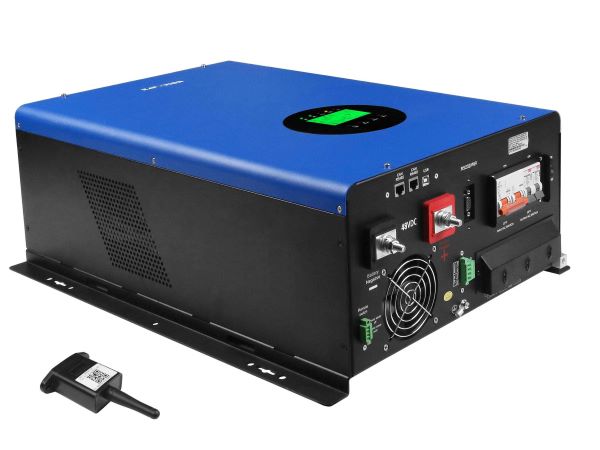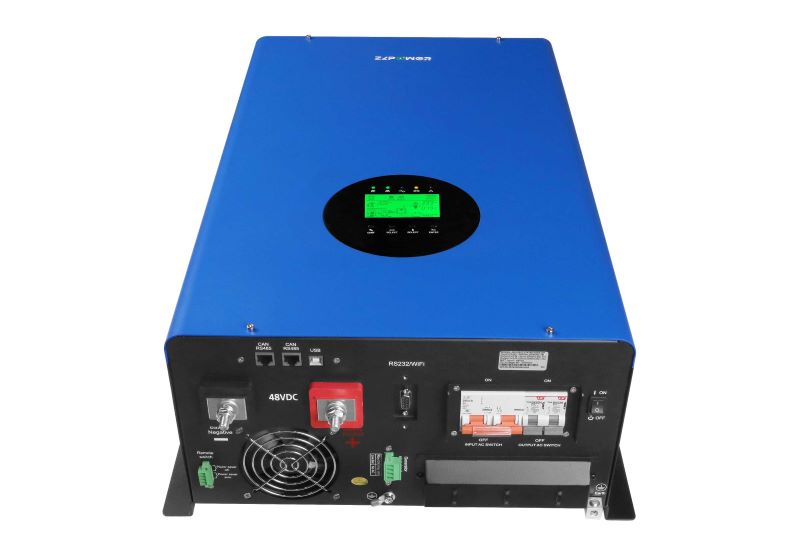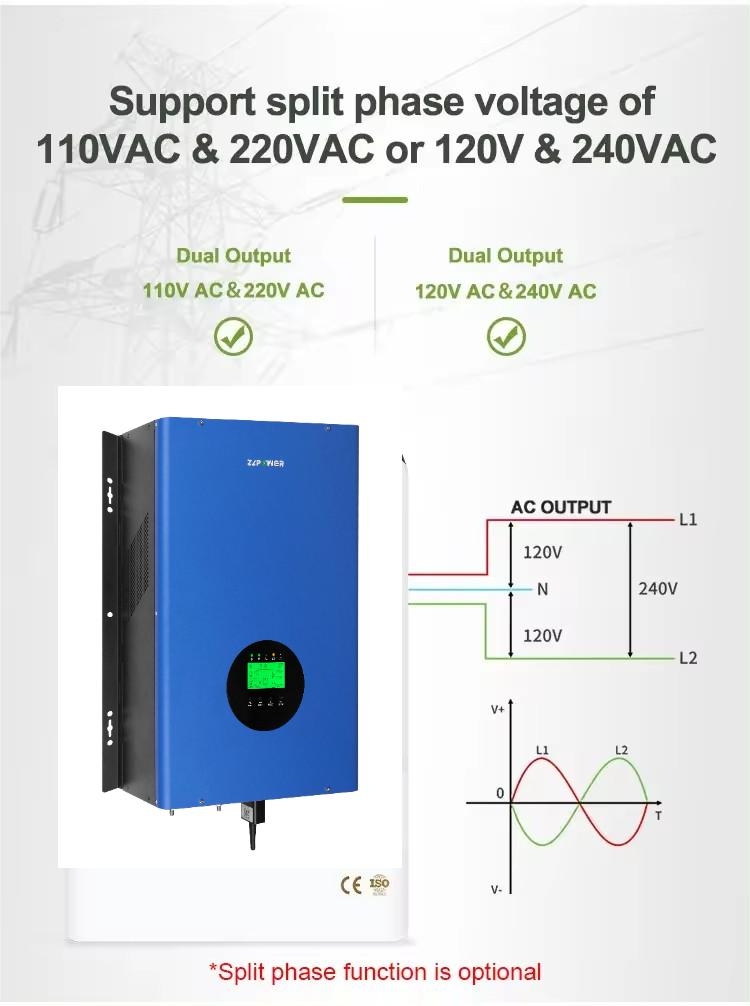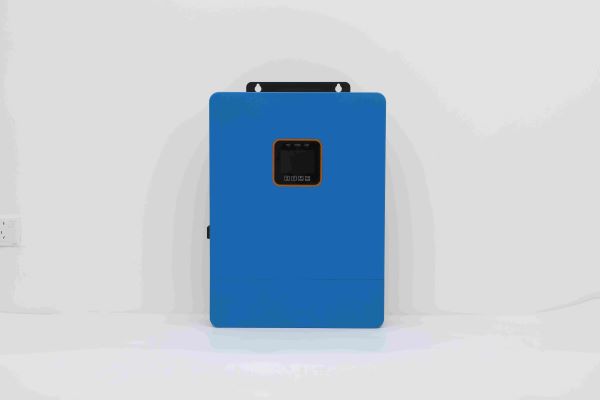

More people are turning to green energy, and solar power systems are popping up everywhere. Split-phase solar inverters are a big part of making these systems work well with modern electrical setups. This article dives into what split-phase power systems are, how split-phase solar inverters function, and all the perks they bring.
Split-phase power systems are super common in homes, especially in North America. They give you two 120V AC lines. You can combine them to get 240V for heavy appliances like dryers. These systems take a single-phase power supply and split it into two equal voltages with a shared neutral wire. This makes energy distribution smooth. It also handles different voltage needs around the house.
A split-phase solar inverter is made to fit perfectly with split-phase power systems. It turns the direct current (DC) from solar panels into alternating current (AC) you can use for home solutions of split-phase solar inverter. These inverters manage both 120V and 240V outputs. They’re great for running everyday gadgets and power-hungry devices like air conditioners or ovens.
Take the GSII 8KW 10KW 12KW Split Phase Hybrid Solar Inverter, for example. It’s packed with cool features like Wi-Fi connectivity, smart safety functions, and support for different battery types.

Split-phase solar inverters change DC electricity from solar panels into AC electricity. They keep things compatible with the dual voltage of split-phase systems. These inverters use clever tech, like Maximum Power Point Tracking (MPPT), to get the most energy possible. MPPT helps pull maximum power from solar panels, even when sunlight changes.
For instance, the PVG high-frequency hybrid inverter has a built-in MPPT controller. It manages DC power well. It also lets users tweak settings on an LCD screen.
Split-phase solar inverters work great with both off-grid and hybrid solar setups. They blend easily with your home’s electrical system. This keeps power flowing during outages or high-demand times. Many newer models don’t even need batteries to work. That’s handy for folks not ready to invest in energy storage yet.
The GSII series works with LifePO4 batteries, AGM batteries, GEL batteries, and deep-cycle batteries. It’s versatile enough for homes, big farms, or other setups.
Split-phase solar inverters spread energy evenly across two phases. This eases the load on circuits. It also makes the whole system run better. They handle both low- and high-voltage needs in one setup, cutting energy waste and boosting performance.
Fancy models like the GSII series use high-quality circuit boards and sine wave tech. These keep power delivery smooth and distortion low.
Split-phase solar inverters are super versatile. They work fine without batteries or pair easily with different battery types for backup power. This makes them great for all kinds of places—homes, factories, villas, or even remote spots.
The PVG hybrid inverter, for example, runs without batteries if needed.
Split-phase solar inverters sync up nicely with today’s grid standards. They make grid-tied operations smooth. Many come with smart monitoring through Wi-Fi or mobile apps. You can check energy use and system performance from anywhere.
The GSII series, for instance, has built-in Wi-Fi for mobile monitoring. It also has LED/LCD displays for better user control.
These features make life easier. They also help you manage energy smarter, which is great for sustainable living.
Hybrid inverters are a game-changer for solar energy systems. They do everything a regular solar inverter does but also handle energy storage. These devices turn DC from solar panels into AC for home use. They also store extra energy in batteries for later. This combo makes energy use more efficient, cuts reliance on the grid, and keeps power reliable.
The GSII 8KW 10KW 12KW Split Phase Hybrid Solar Inverter is a solid example. It has Wi-Fi, smart safety features, and works with various battery types.

Split-phase hybrid inverters are built to work with split-phase power systems common in homes. They convert DC electricity from solar panels into AC that supports both 120V and 240V outputs. This is key for running everyday appliances and heavy equipment like ovens or HVAC units.
Take the PVG high-frequency hybrid inverter. It has a built-in MPPT controller to manage DC power. It also offers customizable settings via an LCD screen.
These inverters use smart algorithms to keep energy conversion efficient, even when sunlight varies. They can also work without batteries, giving users more options if they’re not ready for storage.
Split-phase hybrid inverters shine at pairing solar power with energy storage. They let you save extra solar energy made during the day for use at night or during outages. This boosts energy independence. It also cuts down on using traditional electricity.
The GSII series supports LifePO4, AGM, GEL, and deep-cycle batteries. It’s flexible for homes, farms, or factories.
Many models also have smart charging systems. These manage battery charging and discharging to make batteries last longer.
Split-phase hybrid inverters are great at managing energy across two phases in a home’s electrical setup. This keeps circuits from getting overloaded. It ensures both low- and high-voltage devices work well. Many also have smart monitoring features. These let you track energy use and make adjustments.
Models like the GSII series use high-quality circuit boards and sine wave tech. This keeps power delivery smooth with minimal distortion.
By fitting easily into existing electrical systems, these inverters improve load balancing and overall efficiency.
Split-phase hybrid inverters are perfect for off-grid use or backup power needs. They keep power flowing during outages or emergencies. Their ability to work without the grid makes them ideal for remote areas or places with spotty power.
The PVG hybrid inverter’s battery-independent design means it can run without batteries. This adds to its flexibility.
Many also come with Wi-Fi modules for remote monitoring. You can manage your system from your phone or tablet.

Split-phase hybrid inverters of ZLPOWER are a huge leap forward in solar tech. They blend efficient power conversion with solid energy storage. They work seamlessly with split-phase power systems, fitting modern electrical grids perfectly. They also handle a range of voltage needs in homes. With features like MPPT controllers from ZLPOWER, smart safety functions, and remote monitoring, they’re a must-have for sustainable energy in homes and businesses.
A:Yes, the split-phase Hybrid solar inverters, model PVT mentioned in the article can work without battery that directly convert the solar panel power into 120V/240V Ac power. This battery-independent design gives users flexibility if they’re not ready to invest in energy storage right away.
A: Split-phase hybrid inverters, like the GSII series, support various battery types, including LifePO4, AGM, GEL, and deep-cycle batteries. This makes them versatile for different setups, from homes to farms or factories.